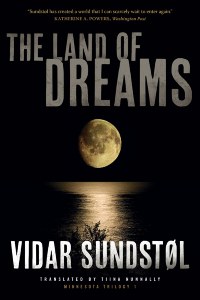What We’re Reading: The Land of Dreams

 The Land of Dreams by Vidar Sundstøl; translated by Tiina Nunnally (University of Minnesota Press, 2014)
The Land of Dreams by Vidar Sundstøl; translated by Tiina Nunnally (University of Minnesota Press, 2014)
Lance Hansen finds his quiet routine as a U.S. Forest Service officer harshly shaken when he discovers a brutal murder of a Norwegian man at Baraga’s Cross in Superior National Forest.
Hansen is an avid, quirky historian in his free time, so much of the story weaves back and forth in time, with a previous unsolved disappearance/possible murder from the early 1900s, to today’s murder. Everyone in town has a history, and Hansen knows it. Eirik Nyland, a Norwegian investigator, is sent to help the FBI sift through the murder, and to talk to the surviving Norwegian man, who was found naked and in shock, not far from the murder scene by Hansen. While the investigators circle around an Ojibwe man as the killer, Hansen starts to suspect someone else through his historically-tinged investigation of the previous murder.
The author, a Norwegian himself, spend a couple years living in northern Minnesota, so the landscape is familiar and accurate. He captures the daily life and idealistic pride of people of Duluth and Grand Marais’ heritage, while using common landmarks that anyone who has been to Duluth or Grand Marais would recognize. With this firm grounding within the setting and atmosphere, the story takes on a realistic edge.
Hansen is a brooding character, with much of his reflection happening with internal dialogue. Yet his external dialogue also captures much of him: straight, to the point, but often bringing in added context of history and facts, such as this conversation when he picks up Nyland from the airport:
“Do you often have weather like this?” [Nyland] asked.
“Fairly often,” replied Lance. “The whole region around the Great Lakes is like this. Sudden, violent storms. Luckily they usually don’t last long. It has to do with the topography. No mountain ranges to block the air masses, either to the north or the south. Just flat plains. Warm air from the Gulf of Mexico forces its way up here, and then meets cold air from the Canadian Arctic. And they slam together.”
“Like now?”
“This is just light entertainment.”
Nyland glanced at Lance Hansen, who was sitting there with his face practically touching the windshield while the wipers slapped frantically back and forth with little effect.
Sundstøl doesn’t stray too far into stereotypes; rather, he writes accurately about the people from which these stereotypes evolved, but with a realistic, multi-faceted perspective. Yes, there are Norwegian descendents who pride themselves on their heritage, despite not knowing much about it. Yet overlooked complexities and bouts of violence creep into what at first seems like a happy little town. Homophoba, tensions between Native Americans and Norwegians, and family lines being questioned all start to pick away at the edges of the idealistic image of a community to reveal the true underbelly of these stereotypes.
Sundstøl writes with direct dialogue, and moments of poetic observation of the world he’s created. Not one for flowery, overly descriptive language, he instead writes with accurate, but detailed sentences that capture the moment at hand, such as Hansen’s view of Lake Superior in this excerpt:
The moon was about a day short of being full. A gleaming streak of moonlight extended from the horizon almost all the way to the tip of his shoes. On land it was so wide that it splintered into thousands of tiny flashes glinting off the waves around him. On both sides of the moonlight, the water was a deep purple that was almost black. He stood there, looking out across the lake without really seeing it.
This is a long novel for a mystery, and is the first in a trilogy, but it kept my attention throughout, save for one lengthy section that reads like a history lesson. It’s a multi-page history of the fur trade in northern Minnesota, which, while interesting, doesn’t connect back to the characters or the story as much as it needs to. It ends up taking me out of the spell Sundstøl has cast with his characters. But soon enough, I’m back in the center of this mystery, lapping it up again.
The Land of Dreams won the Riverton Prize for best Norwegian crime novel, and is the first of Sundstøl’s Minnesota Trilogy, which are all set in northern Minnesota. The ending here isn’t a cliffhanger; it’s more of a subtle itch that doesn’t go away after closing the book.
Are there other authors you know of who use history as the contextual backdrop for their novel? How does a multi-layered story affect the plot line?






Comments are closed.